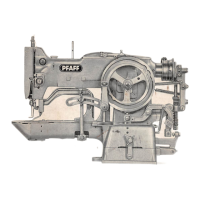3.
Mechanical
Setup
From the foregoing description of the sewing action of a bortocker it is evident
that this machine must incorporate the following essential mechanisms, in
addition
to the shuttle
and
needle
bar
drive mechanisms found in
any
ordinary
sewing machine:
(1)
a special feed
mechanism
which
advances the workpiece in the prede
termined
direction
offer
each
stitch,
(2)
an automatic stop control which stops the machine as soon as the predeter
mined number of stitches
have
been
mode
and
the take-up lever has
almost reached the highest point of its stroke, and
(3)
a trimming mechanism whichsevers the needle and bobbin threads.
a.
Shuttle
and
Needle
Bar
Drive
The shuttle driving motion is derived from the cranked arm shaft and trans
mitted to the shuttle via a connecting rod, an oscillating rock shaft, a crank
with slide block, end the shuttle driver shaft. This mechanical setup produces
the oscillating motion required for this type of shuttle.
The needle
bar
is moved up and down by means of the needle
bar
crank and
the needle
bar
connecting link.
b.
Feed
Motion
The feed motion lengthwise and across the machine bed is controlled by
two pattern-forming grooves, one on either face of the feed cam.
Whenever the material is to be moved in a stroight line lengthwise or across
the machine bed, this motion is controlled by only one of these grooves.
The feed motions emanating from both grooves
are
combined to produce
circular, triangular or other tacks whose sides extend at on angle to the true
lengthwise or crosswise direction of feed.
The groove on the outside face of the feed cam controls the feed motion
crosswise of
the
machine
bed.
As
the
feed
cam
revolves, o
roller
located
at
the top end of the feed across regulator
(Figs.
6 &
7}
rides in this groove
and
transforms the throws
emanating
from its curvature into a reciprocating
motion which is transmitted to both the feed plate carrier bar and the work
clomp by means of a ball joint connection. The amount of motion across
the machine bed can be adjusted by changing the position of the ball joint
connection
in
the
slot of
the
feed
across
regulotor.
13

